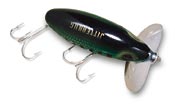
The Apex Tackle Game Fish from Cabela's
Technique:
Extremely versatile and effective, The Apex Game Fish Spoon is a must for every fisherman's tackle box. Whether long casted, trolled, or vertically jigged these spoons produces an excellent wide, wobbling action that entices thunderous strikes from a vast array of freshwater gamefish.
Features:
- wide wobbling action
- Classic tear drop shaped
- Color: Chartreuse w/ orange spots
- Weight: 7/8 oz
The History of Cabela’s
Cabela’s was founded, by chance, in 1961. Dick Cabela managed his parents’ small furniture store in Chappell, Nebraska. In January of ‘61, Dick and his father went on a product-buying trip. At the Navy Pier Housewares Show in Chicago, a small back-corner booth that was marketing inexpensive Japanese fishing equipment caught Dick’s attention. Dick convinced his father that he could sell the flies they were selling ($2.25 a gross) around the furniture store, so they purchased 20 gross (2,880 flies) for $45.
Several months later, not a single fly had sold. It hit Dick that he needed to start advertising. His first ad read, “12 hand-tied fishing flies for $1, postage paid.” Only Mrs. Ernest Lindahl of Casper purchased a package of flies. With nothing to lose, Dick pulled out another ad in Field and Stream magazine that read, “5 hand-tying fishing flies… FREE. 25 cents postage and handling.” Dick knew “free” was a powerful marketing tool and he was right. That day they received 25 orders.
Bolstered by new potential, Dick took out ads in many other magazines with the same ad, greatly increasing his customer base with the attraction of free fishing flies. Realizing the value of his new customer database, Dick scrambled and purchased hooks, lures, reels, and bamboo fly rods and put together Cabela’s first catalog to send out to his new loyal (and growing) following..
By the Spring of ‘62, Cabela’s small business outgrew his pantry and moved to the shed in the backyard. But it didn’t stop there. The business grew to dozens of other buildings before locating to Sidney, NE in ‘73. With a customer first approach, Cabela’s has continued to grow, and now has a 120,000 foot world headquarters in Sidney. The company now has
over 14,000 employees and was ranked No. 1 in the outdoor retailer industry in 2006. And that catalog that Dick originally put together in his basement? Now that catalog has 500 plus pages and is sent to 130 million consumers in all 50 states and 125 countries every year. Not bad for a guy that just wanted to sell some flies out of his furniture store!


